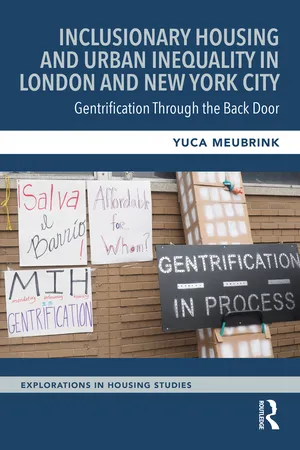
Inclusionary Housing and Urban Inequality in London and New York City
Gentrification Through the Back Door
- 228 pages
- English
- ePUB (mobile friendly)
- Only available on web
Inclusionary Housing and Urban Inequality in London and New York City
Gentrification Through the Back Door
About This Book
Municipalities around the world have increasingly used inclusionary housing programs to address their housing shortages. This book problematizes those programs in London and New York City by offering an empirical, research-based perspective on the socio-spatial dimensions of inclusionary housing approaches in both cities. The aim of those programs is to produce affordable housing and foster greater socio-economic inclusion by mandating or incentivizing private developers to include affordable housing units within their market-rate residential developments.
The starting point of this book is the so-called "poor door" practice in London and New York City, which results in mixed-income developments with separate entrances for "affordable housing" and wealthier market-rate residents. Focusing on this "poor door" practice allowed for a critical look at the housing program behind it. By exploring the relationship between inclusionary housing, new-build gentrification, and austerity urbanism, this book highlights the complexity of the planning process and the ambivalences and interdependencies of the actors involved. Thereby, it provides evidence that the provision of affordable housing or social mixing through this program has only limited success and, above all, that it promotes – in a sense through the "back door" – the very gentrification and displacement mechanisms it is supposed to counteract.
This book will be of interest to researchers and students of housing studies, planning, and urban sociology, as well as planners and policymakers who are interested in the consequences of their own housing programs.
Frequently asked questions
Information
Table of contents
- Cover Page
- Endorsements Page
- Half-Title Page
- Series Page
- Title Page
- Copyright Page
- Dedication Page
- Contents
- List of Figures
- List of Maps
- List of Tables
- List of Boxes
- Acknowledgments
- Acronyms
- Introduction: Rethinking Inclusionary Housing in an Age of Austerity
- 1 Building the Way Out of the Crisis? The Evolution of Inclusionary Housing Policies in London and New York City under Conditions of Austerity
- 2 Creating Value for Profit Rather Than “Affordable Housing”: Neighborhood Regeneration Under the Pretext of Inclusionary Housing
- 3 Reclaiming What, Where, and for Whom? How the Provision of a “Public Good” Contributes to New-Build Gentrification
- 4 Vertical Segregation by Design: How Inclusionary Housing Developments Contribute to a Vertical Gentrification Movement
- 5 Limited Accessibility to and Affordability of “Affordable Housing” as a Form of Gentrification
- Conclusion: Inclusionary Housing as Part of the Problem, Not the Solution to the Housing Affordability Crises
- Afterword: The COVID-19 Pandemic as a Transformative Moment of Inclusionary Housing?
- Index